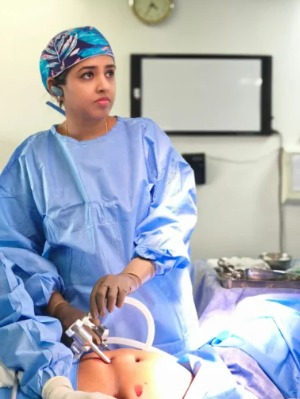Laparoscopic Myomectomy in Jayanagar, Bangalore
Uterine fibroids are non-cancerous growths that develop in or around the uterus, causing symptoms like heavy menstrual bleeding, pain, and pelvic pressure. According to the World Health Organization, approximately 70-80% of women will experience fibroids by the age of 50.
Dr. Usha B.R., founder of Usha Specialty Clinic, says:
“When it comes to managing uterine fibroids, a laparoscopic myomectomy can help women maintain reproductive health and alleviate symptoms. It’s an advanced surgical technique offering a safe, minimally invasive solution, facilitating a quicker return to daily activities. This procedure allows us to target fibroids precisely while preserving the surrounding healthy tissue and reproductive organs.”
Dr. Usha has built a reputation for comprehensive, state-of-the-art gynecological care, supporting women at all stages of life. Her dedication has comforted countless women, making her a sought-after specialist for various procedures, including laparoscopic myomectomy in Jayanagar, Bangalore.
Why Go for Laparoscopic Myomectomy Treatment?
Laparoscopic Myomectomy helps in managing complications caused by uterine fibroids, such as:
Heavy Menstrual Bleeding: Fibroids can cause prolonged, heavy bleeding, leading to anemia and impacting daily life.
Pelvic Pain/Pressure: Many women experience discomfort or pain from fibroids pressing on surrounding organs.
Digestive Problems: Larger fibroids may press on the bladder or intestines, causing digestive and urinary issues.
Pregnancy Complications: Fibroids can interfere with pregnancy, causing pain or even complications in some cases.
It offers several key benefits:
- Preservation of the uterus makes it ideal for those who want to maintain fertility.
- Laparoscopy is a minimally invasive procedure involving small incisions leading to less pain, minimal scarring, and a faster recovery.
- High precision due to enhanced visualization allows for precise fibroid removal.
- Reduced blood loss as compared to traditional surgery.
- Shorter hospital stays and faster return to daily activities.
Types of Laparoscopic Myomectomy Treatments We Provide
At Usha Specialty Clinic, we offer several types of Laparoscopic Myomectomy treatments, including:
Laparoscopic Intramural Myomectomy
This procedure targets fibroids embedded within the muscular wall of the uterus. Dr. Usha B.R. carefully isolates and removes these fibroids to preserve as much uterine tissue as possible. Treating intramural fibroids helps alleviate symptoms and can improve fertility outcomes for women planning to conceive.
Laparoscopic Submucosal Myomectomy

Laparoscopic Subserosal Myomectomy
Laparoscopic Subserosal Myomectomy is focused on removing fibroids growing on the outer surface of the uterine wall. These fibroids can become large and press against surrounding organs, impacting digestion and bladder function. Through minimally invasive techniques, this procedure aims to effectively remove subserosal fibroids, offering a faster recovery time and less scarring compared to traditional surgery.
Robotic Myomectomy
Robotic Myomectomy utilizes advanced robotic assistance for extremely precise and controlled removal of fibroids. With enhanced visualization and range of motion provided by robotic arms, this technique is ideal for complex cases or fibroids in challenging uterus areas. The procedure minimizes trauma to surrounding tissue, reducing recovery time and maximizing uterine preservation, making it a preferred choice for women who wish to maintain optimal uterine health for future family planning.
Are you wondering which type of treatment may be right for you? Speak to an experienced Laparoscopic Myomectomy doctor to find the best fit for your specific needs.
Our Procedure & Approach

Diagnostics



Monitoring

Post-Operating Guidelines


Are you concerned about the financial aspects? We provide clear guidance to help you make an informed decision.
Cost of Laparoscopic Myomectomy in Jayanagar, Bangalore
The average cost of a Laparoscopic Myomectomy in Bangalore varies, generally between INR 80,000 and INR 1,50,000. Specific treatment types may have different costs:
Laparoscopic Intramural Myomectomy: INR 1,00,000 to INR 1,30,000
Are you considering the costs associated with fibroid treatment? Consulting a knowledgeable Laparoscopic Myomectomy specialist can offer clarity and options.
Our Laparoscopic Myomectomy Success Rates & Results
Dr. Usha B.R.’s extensive experience in laparoscopic and robotic procedures has contributed to high success rates, providing over 1,000 women with improved health outcomes. Her dedication to minimally invasive surgery ensures treatments with less scarring and quicker recovery, making a real difference in patients’ lives.
Dr. Usha shares, “Each patient’s journey is unique, and it’s my goal to provide the best outcomes possible by tailoring each treatment. My team and I focus on quality, precision, and care, ensuring each patient feels supported throughout the process.”
Why Choose Us?
Here’s why Usha Specialty Clinic is the go-to center for laparoscopic treatments:
Experienced Surgeon: Dr. Usha B.R. has vast experience in laparoscopic gynecological procedures, ensuring expert care.
Cutting-Edge Technology: We utilize the latest laparoscopic tools, which provide enhanced precision and better outcomes.
Patient-Centric Care: Dr. Usha takes time to understand patient concerns, providing personalized solutions and clear explanations.
Holistic Recovery Support: Beyond the procedure, we support patients with postoperative care, follow-up appointments, and guidance for a smooth recovery journey.
Excellent Track Record: Our clinic’s proven success in laparoscopic surgeries gives patients confidence in achieving their health goals.
Testimonials
FAQs
Can Laparoscopic Myomectomy remove all types of fibroids?
This procedure can address various fibroids, including intramural, subserosal, and submucosal. Depending on the location and size, a tailored approach ensures effective removal.
Is a hospital stay required after a Laparoscopic Myomectomy?
A short hospital stay of 24 to 48 hours is usually required. This helps monitor initial recovery and manage any postoperative discomfort effectively.
How long does it take to recover after Laparoscopic Myomectomy?
Recovery usually takes around 1-2 weeks. Patients can expect to resume light activities within a few days, but a full recovery period allows optimal healing.
Can I conceive after undergoing a Laparoscopic Myomectomy?
Yes, many women can conceive after this procedure. Laparoscopic Myomectomy can improve fertility by removing fibroids that could otherwise interfere with conception.
Are there risks associated with Laparoscopic Myomectomy?
As with any surgery, there are some risks. However, minimally invasive techniques significantly reduce complications. Your surgeon will discuss any potential risks based on your health profile.
Disclaimer: The information shared in this content is for educational purposes only and not for promotional use.
